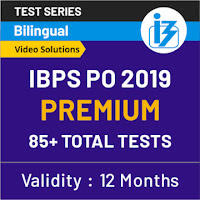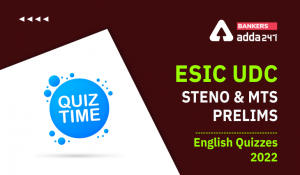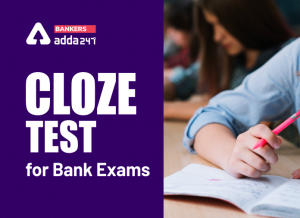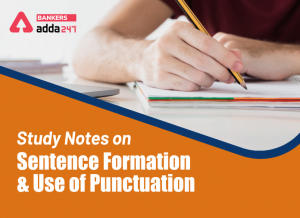Table of Contents
English section can give heebies-jeebies to the students. All the topics in the English section are important from the examination point of view. It is important to prepare each and every section for IBPS PO exam 2019. We have provided you with the IBPS PO study plan so that you are aware of the daily quizzes on each section and can revise the same to attempt the quiz. As the IBPS PO exam is approaching fast, and this is the time to brush up all your knowledge that you have gained so far. Check out the study notes on para jumbles so that you can ace your marks in this section. Check IBPS PO study notes for English section.
STUDY NOTES ON PARA JUMBLES
About Para Jumbles
Para jumbles are jumbled paragraphs. Basically, you are given a paragraph – but the sentences are not in the right order. You have to find the Beginning sentence and look through the mandatory pairs and conclude the passage in the same order. Normally instructions for this type of questions will read as “Choose the most logical order of sentences from among the given choices to construct a coherent paragraph” in IBPS PO Prelims Paper.
Weightage of Para Jumbles in IBPS PO Exam
In order to excel your overall performance in IBPS PO Exam 2019, Para-Jumbles are one of the most important topics that you should not be ignoring. Para-Jumbles cover around 5-10 marks in IBPS PO Prelims level and it covers a minimum of 5 marks in IBPS PO Mains Exam. Hence, prepare this topic considering the number of marks it covers. It will boost up your performance in the exam and increase the overall score. These questions are score booster if you understand their concept.
Here are some hints and rules which can help you have a command over this topic and solve the Questions well.
1. Go through all the sentences:
The most important thing is to go through all the sentences to get an idea about the topic. Try to skim through all the sentences and get an idea of what is telling in the passage.
2. Figuring out the Starting sentence:
After Skimming through all the sentences, the opening or the starting sentence can be easily figured out as it usually depicts a time, name, general topic, concept, etc. It generally will be the one providing some introductory line. Try to find it out after reading all the sentences. The topic is very general in nature. The candidate must visualize the Topic theme while skimming through the passage.
3. Establish a link between the opening sentence and the body of the Para-Jumbles:
The candidate should look through all the mandatory pairs. Once a link is found, you get to know which statements will come together. Then, look in the options. Select the option with those statements coming together. The candidate must look at those sentences that are directly connected. It may be pronoun or Acronyms or starting with the articles which follow the opening sentences.
4. Try to find out all the Mandatory Pairs:
Now, this is the body of the Para-Jumbles one must look at all mandatory pairs.
(A). It can be Noun-Pronoun & Adjective pair.
(B). It can be a Cause-Effect Relationship pair. Words like: Due to, as, since, In order to, Because, So-that, Therefore, Consequently etc. will give a hint to find out these types of pair in the sentences.
(C). It can be a Time sequencing pair. The words like Before, After, Later etc. help you to find out this type of chronology associated in the Para-Jumbles.
(D)It can be followed by Example based Pair. The Theme given in the First sentence is followed by the example associated with it. So a candidate must try to connect those pairs.
5. Now Searching for the Transition Words:
Transition words are words which shows a transition between the sentences, paragraphs, any topics. The purpose of the transition words is to establish a relationship between the sentences. It also tells the forthcoming events coming in the Para-Jumbles.
Some of the transition words which are implicitly related are: Additionally, Also, And, As well, Likewise, Moreover, Furthermore etc.
Some of the transitory words which are explicit in nature are: Nevertheless, Although, Nonetheless, But, Notwithstanding, Despite, On the Contrary, However, While, Yet, Instead of etc.
6. Find the Concluding Statement:
The concluding statement is the one having the conclusion and is the ending sentence. Moreover, it may be the sentence that contains the summary of the whole paragraph in short. The concluding sentence is basically when the author draws a final conclusion. So the candidate must look at those sentences which gives a final concluding theme.
Note: While going through the sentences the candidate must not think that all the sentences are in ascending order. One must look at the Beginning Sentence and further search for the different type of mandatory pairs and finally trying to search the concluding sentence.
By following these steps one can definitely boost the scores in the Para-Jumbles counterpart.
Here is the example of Para-Jumble which will help the candidate to know about this topic.
Types of Para-Jumbles asked in IBPS PO
Directions (1-5): Answer the following questions after rearranging the following sentences into a coherent paragraph.
(A) The Chinese have interpreted Rome’s decision as a historic event that revives ties between the European and Chinese civilizations.
(B) Late last month, during President Xi’s Europe visit, Italy became the first G7 country to formally subscribe to the China-led BRI.
(C) During his visit, President Xi also spoke about joint venture prospects in other countries, including in Africa.
(D) That apparently tickled a nostalgic nerve in European capitals, where it has been difficult to separate the guilt of colonization from a whiff of romance.
(E) As the countdown begins for the second edition of the Belt and Road Forum (BRF) later this month, Beijing is jubilant.
(F) Last month, China demonstrated that President Xi Jinping’s Belt and Road Initiative (BRI) had steamed into the heart of Europe.
Q1. What should be the FOURTH sentence after rearrangement?
(a) F
(b) A
(c) B
(d) C
(e) D
Q2. What should be the THIRD sentence after rearrangement?
(a) D
(b) C
(c) A
(d) B
(e) F
Q3. What should be the LAST sentence after rearrangement?
(a) F
(b) C
(c) B
(d) F
(e) D
Q4. What should be the SECOND sentence after rearrangement?
(a) F
(b) B
(c) C
(d) D
(e) E
Q5. What should be the FIRST sentence after rearrangement?
(a) F
(b) D
(c) E
(d) A
(e) C
S1. Ans. (b)
Sol. The correct sequence is EFBACD.
The sentence (E) introduces the theme of the paragraph which is ‘second edition of the Belt and Road Forum (BRF). So, the sentence (E) should be the First sentence after rearrangement.
Among sentences (F) and (B), sentence (F) starts with ‘last month’ and sentence (B) starts with ‘late last month’. As per sequence, sentence (F) should come first and sentence (B) should follow it.
So, sentence (F) should be the SECOND sentence after rearrangement.
And, sentence (B) should be the THIRD sentence after rearrangement.
The sentence (B) introduces new information that Italy became the first G7 country to formally subscribe to the China-led BRI. While sentence (A) tells about how Chinese have interpreted Rome’s decision to formally subscribe to BRI. So, sentence (A) should be the FOURTH sentence after rearrangement.
Sentence (C) and sentence (D) further informs about what Xi said during his visit to Europe and the implication of his speech. President Xi during his visit to Europe said about joint venture prospects in other countries, including in Africa while sentence (D) informs about that that tickled a nostalgic nerve in European capitals.
So, sentence (C) should be the FIFTH sentence after rearrangement and sentence (D) should be the SIXTH sentence after rearrangement.
So, the correct sequence is EFBACD.
So, sentence (A) would be the FOURTH sentence after rearrangement.
Hence, option (b) is the correct answer.
S2. Ans. (d)
Sol. The correct sequence is EFBACD.
The sentence (E) introduces the theme of the paragraph which is ‘second edition of the Belt and Road Forum (BRF). So, the sentence (E) should be the First sentence after rearrangement.
Among sentences (F) and (B), sentence (F) starts with ‘last month’ and sentence (B) starts with ‘late last month’. As per sequence, sentence (F) should come first and sentence (B) should follow it.
So, sentence (F) should be the SECOND sentence after rearrangement.
And, sentence (B) should be the THIRD sentence after rearrangement.
The sentence (B) introduces new information that Italy became the first G7 country to formally subscribe to the China-led BRI. While sentence (A) tells about how Chinese have interpreted Rome’s decision to formally subscribe to BRI. So, sentence (A) should be the FOURTH sentence after rearrangement.
Sentence (C) and sentence (D) further informs about what Xi said during his visit to Europe and the implication of his speech. President Xi during his visit to Europe said about joint venture prospects in other countries, including in Africa while sentence (D) informs about that that tickled a nostalgic nerve in European capitals.
So, sentence (C) should be the FIFTH sentence after rearrangement and sentence (D) should be the SIXTH sentence after rearrangement.
So, the correct sequence is EFBACD.
So, sentence (B) would be the THIRD sentence after rearrangement.
Hence, option (d) is the correct answer.
S3. Ans. (e)
Sol. The correct sequence is EFBACD.
The sentence (E) introduces the theme of the paragraph which is ‘second edition of the Belt and Road Forum (BRF). So, the sentence (E) should be the First sentence after rearrangement.
Among sentences (F) and (B), sentence (F) starts with ‘last month’ and sentence (B) starts with ‘late last month’. As per sequence, sentence (F) should come first and sentence (B) should follow it.
So, sentence (F) should be the SECOND sentence after rearrangement.
And, sentence (B) should be the THIRD sentence after rearrangement.
The sentence (B) introduces new information that Italy became the first G7 country to formally subscribe to the China-led BRI. While sentence (A) tells about how Chinese have interpreted Rome’s decision to formally subscribe to BRI. So, sentence (A) should be the FOURTH sentence after rearrangement.
Sentence (C) and sentence (D) further informs about what Xi said during his visit to Europe and the implication of his speech. President Xi during his visit to Europe said about joint venture prospects in other countries, including in Africa while sentence (D) informs about that that tickled a nostalgic nerve in European capitals.
So, sentence (C) should be the FIFTH sentence after rearrangement and sentence (D) should be the SIXTH sentence after rearrangement.
So, the correct sequence is EFBACD.
So, sentence (D) would be the LAST sentence after rearrangement.
Hence, the option (e) is the correct answer.
S4. Ans. (a)
Sol. The correct sequence is EFBACD.
The sentence (E) introduces the theme of the paragraph which is ‘second edition of the Belt and Road Forum (BRF). So, the sentence (E) should be the First sentence after rearrangement.
Among sentences (F) and (B), sentence (F) starts with ‘last month’ and sentence (B) starts with ‘late last month’. As per sequence, sentence (F) should come first and sentence (B) should follow it.
So, sentence (F) should be the SECOND sentence after rearrangement.
And, sentence (B) should be the THIRD sentence after rearrangement.
The sentence (B) introduces new information that Italy became the first G7 country to formally subscribe to the China-led BRI. While sentence (A) tells about how Chinese have interpreted Rome’s decision to formally subscribe to BRI. So, sentence (A) should be the FOURTH sentence after rearrangement.
Sentence (C) and sentence (D) further informs about what Xi said during his visit to Europe and the implication of his speech. President Xi during his visit to Europe said about joint venture prospects in other countries, including in Africa while sentence (D) informs about that that tickled a nostalgic nerve in European capitals.
So, sentence (C) should be the FIFTH sentence after rearrangement and sentence (D) should be the SIXTH sentence after rearrangement.
So, the correct sequence is EFBACD.
So, sentence (F) would be the SECOND sentence after rearrangement.
Hence, option (a) is the correct answer.
S5. Ans. (c)
Sol. The correct sequence is EFBACD.
The sentence (E) introduces the theme of the paragraph which is ‘second edition of the Belt and Road Forum (BRF). So, the sentence (E) should be the First sentence after rearrangement.
Among sentences (F) and (B), sentence (F) starts with ‘last month’ and sentence (B) starts with ‘late last month’. As per sequence, sentence (F) should come first and sentence (B) should follow it.
So, sentence (F) should be the SECOND sentence after rearrangement.
And, sentence (B) should be the THIRD sentence after rearrangement.
The sentence (B) introduces new information that Italy became the first G7 country to formally subscribe to the China-led BRI. While sentence (A) tells about how Chinese have interpreted Rome’s decision to formally subscribe to BRI. So, sentence (A) should be the FOURTH sentence after rearrangement.
Sentence (C) and sentence (D) further informs about what Xi said during his visit to Europe and the implication of his speech. President Xi during his visit to Europe said about joint venture prospects in other countries, including in Africa while sentence (D) informs about that that tickled a nostalgic nerve in European capitals.
So, sentence (C) should be the FIFTH sentence after rearrangement and sentence (D) should be the SIXTH sentence after rearrangement.
So, the correct sequence is EFBACD.
So, sentence (E) would be the FIRST sentence after rearrangement.
Hence, the option (c) is the correct answer.




 English Quizzes For ESIC- UDC, Steno, MT...
English Quizzes For ESIC- UDC, Steno, MT...
 Tips To Solve Cloze Test Questions In En...
Tips To Solve Cloze Test Questions In En...
 Study Notes on Sentence Formation and Us...
Study Notes on Sentence Formation and Us...



